Early spring blooming wildflowers are typically small, lovely, and very delicate looking. But looks can be deceiving. Most are actually very tenacious, often with multiple strategies geared to enable them to survive and reproduce. Take the Hepaticas (Anemone americana, A. acutiloba) for example.
They are among the earliest blooming spring wildflowers, starting as early as mid-March in the southern part of their range to as late as May in the northernmost areas. The flower stalks emerge from their blanket of fallen leaves and bloom well before the new season’s leaves unfurl on the trees above them.
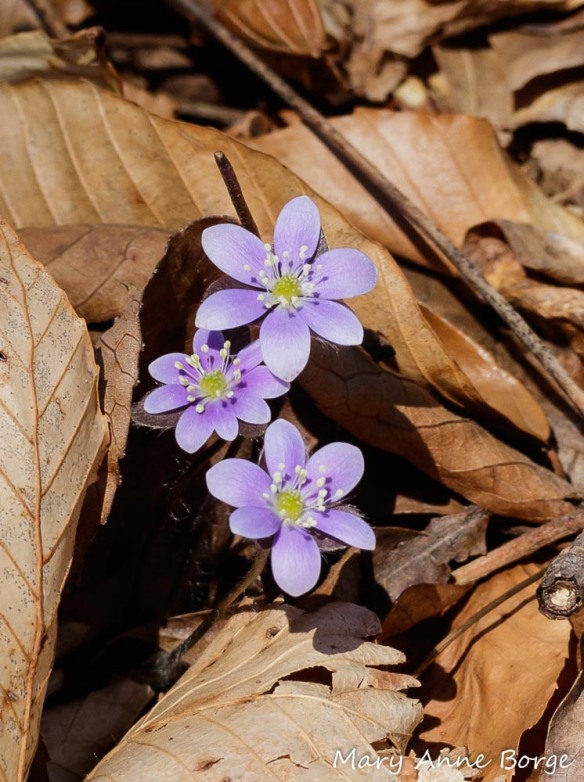
Round-lobed Hepatica (Anemone americana, synonym Hepatica nobilis var. obtusa) emerging from its blanket of leaves
Hepatica is able to get a head start on the blooming season because its leaves remain viable throughout the winter, gathering energy and photosynthesizing when the conditions permit. When the warmer spring days arrive, Hepatica is ready to go full steam ahead with photosynthesis. The overwintering leaves may be green, or mottled with maroon.

Round-lobed Hepatica (Anemone americana, synonym Hepatica nobilis var. obtusa); note its evergreen leaves
Hepatica produces bright flowers in shades from white to deep blue-violet, perfect for enticing pollinators to assist with cross-pollination. The flowers contrast well with the browns and tans of the decomposing leaf mulch surrounding them, beckoning to early flying solitary bees and flies.
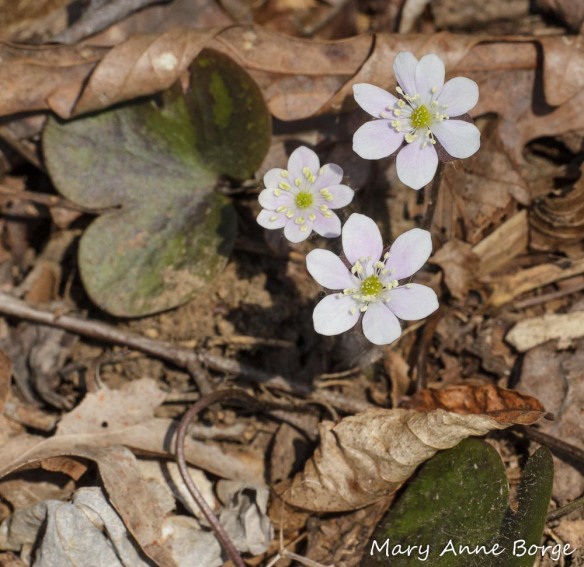
Round-lobed Hepatica (Anemone americana, synonym Hepatica nobilis var. obtusa); with whitish flowers and mottled leaves
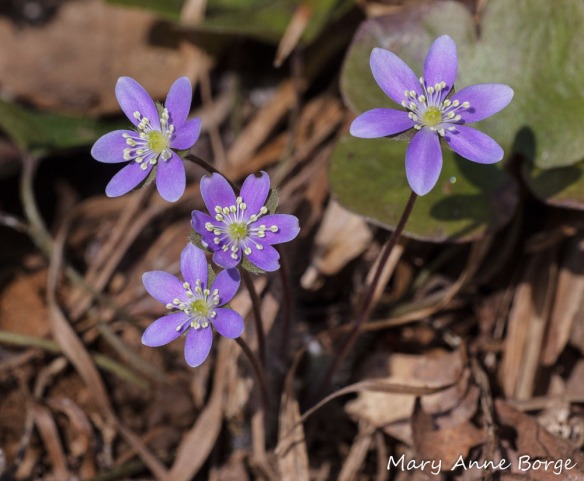
Round-lobed Hepatica (Anemone americana, synonym Hepatica nobilis var. obtusa); with deep violet flowers
Hepaticas have a short blooming season, at a time of year when weather can be unpredictable. It’s more difficult to photosynthesize in cool temperatures, so plants have to be very efficient about how they allocate their energy. The early flying solitary bees and flies that are their likely pollination partners are interested in nectar, but they need pollen even more. Many bees and flies consume pollen for the nutrients it provides, and female bees also harvest pollen to feed their larva. Pollen is a very effective reward to attract these visitors, so effective that Hepaticas have evolved not to put any energy into producing nectar.
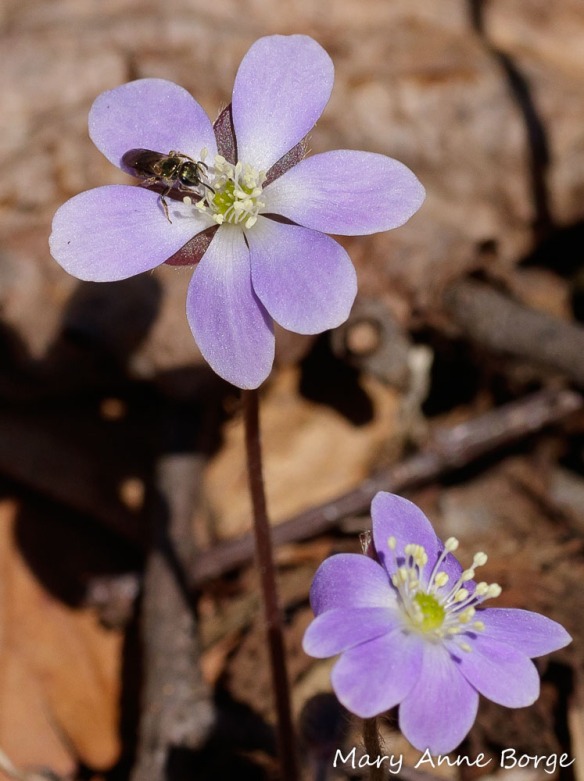
Round-lobed Hepatica (Anemone americana, synonym Hepatica nobilis var. obtusa); with bee harvesting pollen
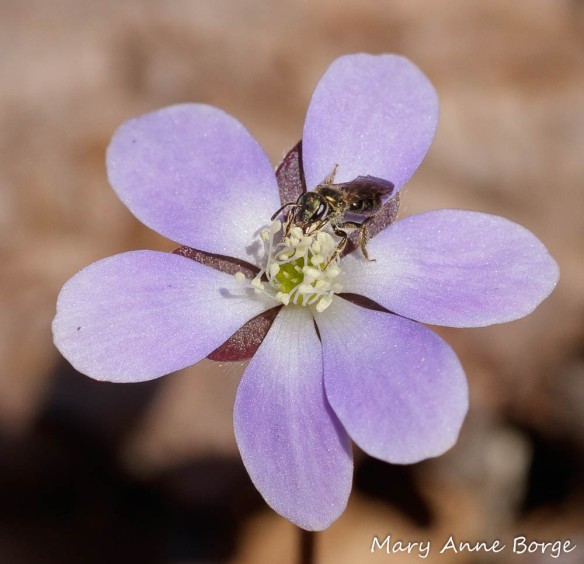
Round-lobed Hepatica (Anemone americana, synonym Hepatica nobilis var. obtusa); with bee harvesting pollen
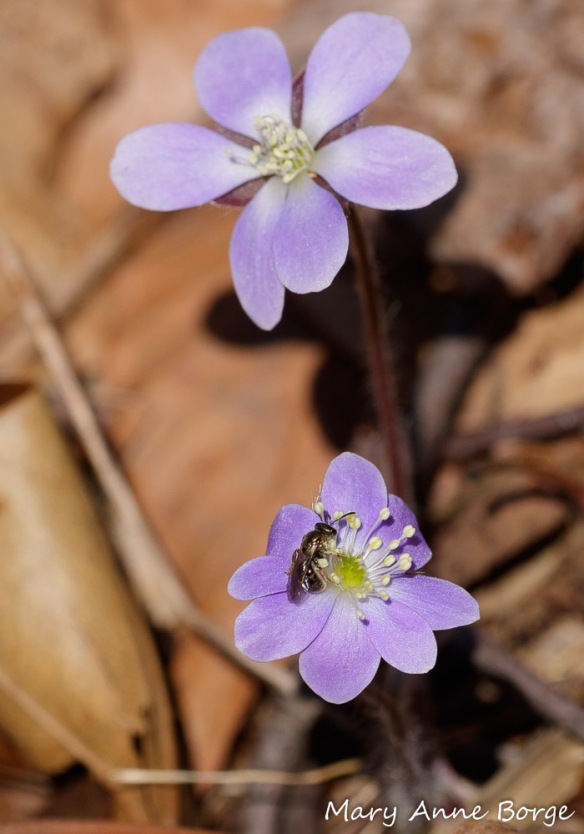
The bee moves on to another flower. Round-lobed Hepatica (Anemone americana, synonym Hepatica nobilis var. obtusa); with bee harvesting pollen
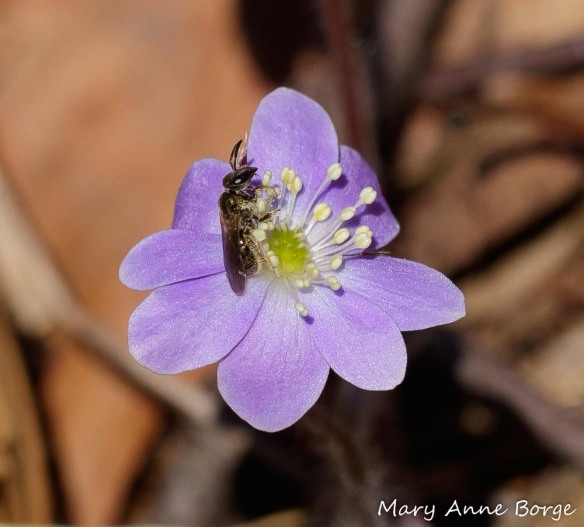
Round-lobed Hepatica (Anemone americana, synonym Hepatica nobilis var. obtusa); with bee harvesting pollen
Hepatica does hedge its bets a little. It protects its pollen by closing its flowers at night, and on rainy days. Cross-pollination with the assistance of an insect is preferred, since a stronger genetic result is more likely. But if that doesn’t happen, Hepaticas are able to self-pollinate. It’s better than not reproducing at all.
Regardless of how pollination is achieved, ants disperse Hepatica seeds, as they do for about 30% of spring blooming plants in the forests of the northeast. They are enticed to do this by the nutritious food packets, called elaiosome, that are attached to the seeds. Ants take the seeds back to their nests, eat the elaiosome, and discard the seed, usually in a location that is rich in soil nutrients and safe from seed-eating birds.
Hepaticas employ two strategies to protect themselves from being eaten by browsing insects or larger animals. Like many members of the Buttercup (Ranunculaceae) family, their leaves are toxic. The newly emerging flower stems, bracts and leaves, as well as the fruits (achenes) that develop later, are all hairy, a characteristic that discourages herbivores, and may also help to keep the plant’s tissues warm during cool spring days and nights.
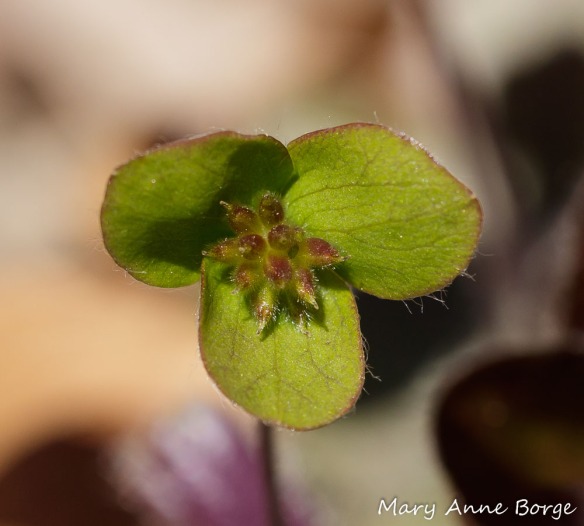
Hairy fruit capsules and bracts of Round-lobed Hepatica (Anemone americana, synonym Hepatica nobilis var. obtuse)
Hepatica gets its name from its resemblance to a human liver, both in shape and in the maroon color often seen in its leaves. ‘Hepatica’ is derived from a Greek word that means ‘the liver’. Other common names for Hepatica are Liverleaf and Liverwort.
There was a period during which it was thought that if a plant resembled a body part, it would be effective in treating diseases of that body part (the ‘Doctrine of Signatures’). As a result, the Hepatica (Hepatica nobilis) native to Europe was used in preparations for treating liver ailments for many years, but more recent scientific testing of Hepatica has refuted its efficacy.
There are two Hepaticas in North America, Round-lobed Hepatica (Anemone Americana, synonym Hepatica nobilis var. obtusa) and Sharp-lobed Hepatica (Anemone acutiloba, synonym Hepatica nobilis var. acuta). They are named for the shape of the lobes of their leaves. Aside from that, they look the same. They are so similar to each other and to the European Hepatica (Hepatica nobilis), that some experts consider the North American species are sub-species of Hepatica nobilis.
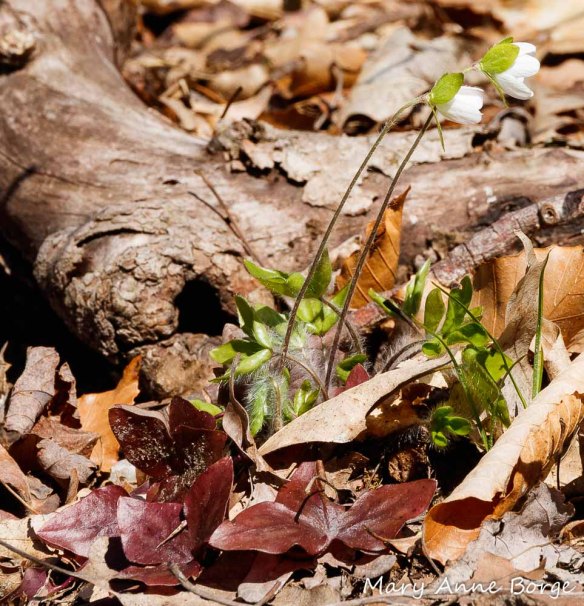
Sharp-lobed Hepatica (Anemone acutiloba, synonym Hepatica nobilis var. acuta); Notice the maroon leaves from the previous season; the pointed lobes distinguish this species from Round-lobed Hepatica. The new leaves, flower stems, bracts, and even the flowers are hairy.
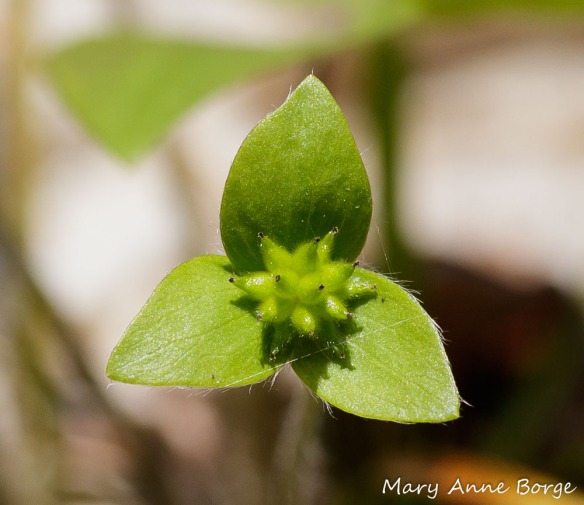
Hairy fruit capsules and pointed bracts of Sharp-lobed Hepatica (Anemone acutiloba, synonym Hepatica nobilis var. acuta)
Both the North American Hepaticas can be found in rich woodlands, often on dry upland slopes. Sharp-lobed Hepatica has a preference for rocky soils that have a higher calcium content. Both can be found in Manitoba, Ontario and Quebec provinces in Canada. In the United States, Round-lobed Hepatica may be found from Minnesota to Maine, south to Arkansas and the Florida panhandle, but it is more common in the northern and eastern part of its range. Sharp-lobed hepatica has a similar U.S. range, it is more common in the northern and central parts of its range. It has not been reported in New Jersey or Florida.
So Hepatica’s survival strategy includes winter-hardy leaves to enable winter and early spring photosynthesis, hairy, toxic foliage to deter herbivores, produce flowers that entice pollinators, but self-pollinate if necessary, and partner with ants for seed dispersal. Seems pretty comprehensive!
Related Posts
A Carpet of Spring Beauty, Woven by Ants
Resources
Eaton, Eric R.; Kauffman, Ken. Kaufman Field Guide to Insects of North America. 2007.
Eastman, John. The Book of Forest and Thicket. 1992.
Foster, Steven; Duke, James A. A Field Guide to Medicinal Plants and Herbs of Eastern and Central North America. 2000.
Rhoads, Ann Fowler; Block, Timothy A. The Plants of Pennsylvania. 2007
Spira, Timothy A. Wildflowers & Plant Communities of the Southern Appalachian Mountains & Piedmont. 2011.
USDA NRCS Plant Database
https://www.plants.usda.gov/core/profile?symbol=HENOO
https://plants.usda.gov/core/profile?symbol=HENOA

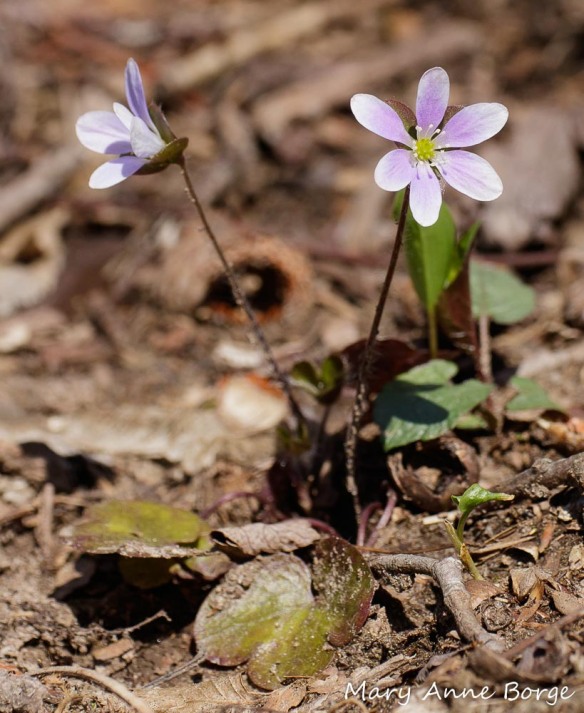
Excellent article and fabulous photos! So interesting how the ants plant the seeds.
Thank you, Sue!
I really liked it.Thank you! It really helped with my research for school!
I’m glad the post helped you. Good luck in school!
Pingback: Goldthread | The Natural Web
Pingback: Rue Anemone and a Bee Fly | The Natural Web
Pingback: Bloodroot | The Natural Web
Really interesting! Thanks, Bobbie
Glad you enjoyed it.
How funny to get this now – just as I’m charging my camera battery to go out into our neighbourhood woods and look for them! I saw them for the first time in our woods a week ago – and was thrilled. Fingers crossed for spotting some more today – maybe in colours other than white
Good luck on your search!
Magnificent artistry and useful information….thank you for sharing your work. I appreciated being able to access your May 3, 2014 work on ephemerals, too. Saturday morning at Tyler State park displayed a bonanza. What a thrill learning these plants.
Gratefully,
Patricia Merkel
Nature is endlessly fascinating!
Thank you, Mary Anne. That was wonderful!
Glad you enjoyed it!
It’s so helpful to have this comprehensive overview of the Hepaticas. Well done!
Thank you!